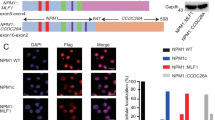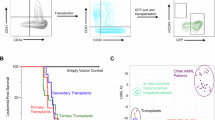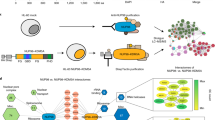Abstract
NUP98 is fused to a variety of partner genes, including abdominal B-likeHOX, in human myeloid and T-cell malignancies via chromosomal translocation involving 11p15.NUP98 encodes a 98-kd nucleoporin that is a component of the nuclear pore complex and functions in nucleocytoplasmic transport, with its N-terminal GLFG repeats used as a docking site for karyopherins. Disruption of NUP98 may affect the nuclear pore function, and the abnormal expression and altered function of fusion partners may also be critical for leukemia development. Recent studies using mouse models expressingNUP98-HOX have confirmed its leukemogenic potential, and cooperative genes forNUP98-HOXA9 in leukemogenesis have been identified in these studies. Thus, the NUP98 chimera is a unique molecule that provides valuable information regarding nuclear pore function and the role of the homeobox protein in leukemogenesis/carcinogenesis.
Similar content being viewed by others
References
Radu A, Moore MS, Brobel G. The peptide repeat domain of nucleoporin Nup98 functions as a docking site in transport across the nuclear pore complex.Cell. 1995;81:677–690.
Powers MA, Macaulay C, Masiarz FR, Forbes DJ. Reconstituted nuclei depleted of a vertebrate GLFG nuclear pore protein, p97, import but are defective in nuclear growth and replication.J. Biol Chem. 1995;128:721–736.
Nakamura T, Largaespada DA, Lee MP, et al. Fusion of the nucleoporin geneNUP98 toHOXA9 by the chromosome translocation t(7;11)(p15;p15) in human myeloid leukaemia.Nat Genet. 1996;12:154–1588.
Borrow J, Shearman AM, Stanton VP, et al. The t(7;11)(p15;p15) translocation in acute myeloid leukaemia fuses the genes for nucleoporin NUP98 and class I homeoprotein HOXA9.Nat Genet. 1996;12:159–167.
Arai Y, Hosoda F, Kobayashi H, et al. The inv(11)(p15q22) chromosome translocation of de novo and therapy-related myeloid malignancies results in fusion of the nucleoporin gene,NUP98, with the putative RNA helicase gene,DDX10.Blood. 1997;89:3936–39444.
Raza-Egilmez SZ, Jani-Sait SN, Grossi M, Higgins MJ, Shows TB, Apian PD. NUP98-HOXD13 gene fusion in therapy-related acute myelogenous leukemia.Cancer Res. 1998;58:4269–4273.
Nakamura T, Yamazaki Y, Hatano Y, Miura I.NUP98 is fused toPMX1 homeobox gene in human acute myelogenous leukemia with chromosome translocation t(1;11)(q23;p15).Blood. 1999;94:741–7477.
Hussey DJ, Nicola M, Moore S, Peters GB, Dobrovic A. The (4;11) (q21;p15) translocation fuses theNUP98 andRAP1GDS genes and is recurrent in T-cell acute lymphocytic leukemia.Blood. 1999;94:2072–2079.
Ahuja HG, Felic CA, Apian PD. The t(11;20)(p15;q15) chromosomal translocation associated with therapy-related myelodysplastic syndrome results in anNUP98-TOP1 fusion.Blood. 1999;94:3258–32611.
Jaju RJ, Fidler C, Haas OA, et al. A novel gene,NSD1, is fused toNUP98 in the t(5;11)(q35;p15) in de novo childhood acute myeloid leukemia.Blood. 2001;98:1264–1267.
Taketani T, Taki T, Shibuya N, et al. TheHOXD11 gene is fused to theNUP98 gene in acute myeloid leukemia with t(2;11)(q31;p15).Cancer Res. 2002;62:33–37.
Taketani T, Taki T, Shibuya N, et al. Novel NUP98-HOXC11 fusion gene resulted from a chromosomal break within exon 1 of HOXC11 in acute myeloid leukemia with t(11;12)(p15;q13).Cancer Res. 2002;62:4571–4574.
Ahuja HG, Hong J, Apian PD, et al. t(9;11)(p22;p15) in acute myeloid leukemia results in a fusion betweenNUP98 and the gene encoding transcriptional coactivators p52 and p75-lens epithelium- derived growth factor (LEDGF).Cancer Res. 2000;60:6227–6229.
Fujino T, Suzuki A, Ito Y, et al. Single-translocation and double- chimeric transcripts: detection ofNUP98-HOXA9 in myeloid leukemias withHOXA11 orHOXA13 breaks of the chromosomal translocation t(7;11)(p15;p15).Blood. 2002;99:1428–1433.
Rosati R, La Starza R, Veronese A, et al.NUP98 is fused to theNSD3 gene in acute myeloid leukemia associated with t(8;11)(p11.2;p15).Blood. 2002;99:3857–3860.
Panagopoulos I, Isaksson M, Billstrom R, Strombeck B, Mitelman F, Johansson B. Fusion of theNUP98 gene and the homeobox geneHOXC13 in acute myeloid leukemia with t(11;12)(p15;q13).Genes Chromosomes Cancer. 2003;36:107–112.
Lahortiga I, Vizmanos JL, Agirre X, et al.NUP98 is fused toAdducin 3 in a patient with T-cell acute lymphoblastic leukemia and myeloid markers, with a new translocation t(10;11)(q25;p15).Cancer Res. 2003;63:3079–3083.
Nakielny S, Dreyfuss G. Transport of proteins and RNAs in and out of the nucleus.Cell. 1999;99:677–690.
Rout MP, Wente SR. Pores for thought: nuclear pore complex proteins.Trends Genet. 1994;4:357–365.
Rout MP, Aitchison JD, Suprapto A, Hjertaas K, Zhao Y, Chai BT. The yeast nuclear pore complex: composition, architecture, and transport mechanism.J. Cell Biol. 2000;148:635–651.
Cronshaw JM, Krutchinsky AN, Zhang W, Chait BT, Matunis MJ. Proteomic analysis of the mammalian nuclear pore complex.J. Cell Biol. 2002;158:915–927.
Rosenblum JS, Blobel G. Autoproteolysis in nucleoporin biogenesis.Proc Natl Acad Sci USA. 1999;96:11370–11375.
Fontoura BM, Blobel G, Matunis MX. A conserved biogenesis pathway for nucleoporins: proteolytic processing of a 186-kilodalton precursor generates Nup98 and the novel nucleoporin Nup96.J. Cell Biol. 1999;144:1097–1112.
Griffls ER, Xu S, Powers MA. Nup98 localizes to both nuclear and cytoplasmic sides of the nuclear pore and binds to two distinct nucleoporin subcomplexes.Mol Biol Cell. 2003;14:600–610.
Fornerod M, van DeursenJ, van Baal S, et al. The human homologue of yeast CRM1 is in a dynamic subcomplex with CAN/ Nup214 and a novel nuclear pore component Nup88.EMBO J. 1997;16:807–816.
Neville M, Stutz F, Lee L, Davis LI, Rosbash M. The importin-beta family member Crmlp bridges the interaction between Rev and the nuclear pore complex during nuclear export.Curr Biol. 1997;7:767–7755.
Pritchard CE, Fornerod M, Kasper KH, van Deursen JM. RAE1 is a shuttling mRNA export factor that binds to a GLEBS-like NUP98 motif at the nuclear pore complex through multiple domains.J. Cell Biol. 1999;145:237–254.
Blevins MB, Smith AM, Phillips EM, Powers MA. Complex formation among the RNA export proteins Nup98, Rael/Gle2 and TAP.J. Biol Chem. 2003;278:20979–20988.
Dasso M. Running on Ran: nuclear transport and the mitotic spindle.Cell. 2001;104:321–324.
Stoffler D, Goldie KN, Feja B, Aebi U. Calcium-mediated structural changes of nuclear pore complexes monitored by time-lapse atomic force microscopy.J. Mol Biol. 1999;287:741–752.
Griffls ER, Altan N, Lippincott-Schwartz J, Powers MA. Nup98 is a mobile nucleoporin with transcription-dependent dynamics.Mol Biol Cell. 2002;13:1282–1297.
Zolotukhin AS, Felber BK. Nucleoporins Nup98 and Nup214 participate in nuclear export of human immunodeficiency virus type 1 Rev.J. Virol. 1999;73:120–127.
Wu X, Kasper LH, Mantcheva RT, Matchev GT, Springett MJ, van DeursenJM. Disruption of the FG nucleoporin NUP98 causes selective changes in nuclear pore complex stoichiometry and function.Proc Natl Acad Sci USA. 2001;98:3191–3196.
von LindernM, Fornerod M, van Baal S, et al. The translocation (6;9), associated with a specific subtype of acute myeloid leukemia, results in the fusion of two genes, dek and can, and the expression of a chimeric, leukemia-specific dek-can mRNA.Mol Cell Biol. 1992;12:1687–1697.
Kau TR, Way JC, Silver PA. Nuclear transport and cancer: from mechanism to intervention.Nat Rev Cancer. 2004;4:106–117.
Kasper LH, Brindle PK, Schnabel CA, Pritchard CE, Cleary ML, van DeursenJM. CREB binding protein interacts with nucleo- porin-specific FG repeats that activate transcription and mediate NUP98-HOXA9 oncogenicity.Mol Cell Biol. 1999;19:764–776.
Ghannam G,Takeda A, CamarataT, Moore MA, Viale A, Yaseen NR. The oncogeneNup98-HOXA9 induces gene transcription in myeloid cells.J. Biol Chem. 2004;279:866–875.
Hussey DJ, Dobrovic A. Recurrent coiled-coil motifs in NUP98 fusion partners provide a clue to leukemogenesis.Blood. 2002;99:1097–10988.
Fontoura BMA, Dales S, Blobel G, Zhong H. The nucleoporin Nup98 associates with the intranuclear filamentous protein network of TPR.Proc Natl Acad Sci USA. 2001;98:3208–3213.
Krull S, Thyberg J, Bjorkroth B, Rackwitz HR, Cordes VC. Nucleoporins as components of the nuclear pore complex core structure and Tpr as the architectural element of the nuclear basket.Mol Biol Cell. 2004;15:4261–4277.
Frosst P, Guan T, Subauste C, Hahn K, Gerace L. Tpr is localized within the nuclear basket of the pore complex and has a role in nuclear protein export.J. Cell Biol. 2002;156:617–630.
Askjaer P, Bachi A, Wilm M, et al. RanGTP-regulated interactions of CRM1 with nucleoporins and a shuttling DEAD-box helicase.Mol Cell Biol. 2002;156:617–630.
Manak JR, Scott MP. A class act: conservation of homeodomain protein functions.Development. 1994;120(suppl):61–71.
Kehrl JH. Homeobox genes in hematopoiesis.Crit Rev Oncol Hematol. 1994;16:145–156.
Lawrence HJ, Sauvageau G, Humphries RK, Largman C. The role of HOX homeobox genes in normal and leukemic hematopoiesis.Stem Cells. 1996;14:281–291.
Sauvageau G, Lansdorp PM, Eaves CJ, et al. Differential expression of homeobox genes in functionally distinct CD34+ subpopulations of human bone marrow cells.Proc Natl Acad Sci USA. 1994; 91:12223–12227.
Thorsteinsdottir U, Sauvageau G, Hogh MR, et al. Overexpression of HOXA10 in murine hematopoietic cells perturbs both myeloid and lymphoid differentiation and leads to acute myeloid leukemia.Mol Cell Biol. 1997;17:495–505.
Buske C, Feuring-Buske M, Antonchuk J, et al. Overexpression ofHOXA10 perturbs human lymphomyelopoiesis in vitro and in vivo.Blood. 2001;97:2286–2292.
Care A, Valtieri M, Mattia G, et al. Enforced expression of HOXB7 promotes hematopoietic stem cell proliferation and myeloid- restricted progenitor differentiation.Oncogene. 1999;18:1993–2001.
Fujino T, Yamazaki Y, Largaespada DA, et al. Inhibition of myeloid differentiation by Hoxa9, Hoxb8, and Meis homeobox genes.Exp Hematol. 2001;29:856–863.
Krishnaraju K, Hoffman B, Liebermann DA. Lineage-specific regulation of hematopoiesis by HOX-B8 (HOX-2.4): inhibition of granulocytic differentiation and potentiation of monocytic differentiation.Blood. 1997;90:1840–1849.
Antonchuk J, Sauvageau R, Humphries RK. HOXB4-induced expansion of adult hematopoietic stem cells ex vivo.Cell. 2002;109:39–45.
Kyba M, Perlingeiro RCR, Daley GQ. HoxB4 confers definitive lymphoid-myeloid engraftment potential on embryonic stem cell and yolk sac hematopoietic progenitors.Cell. 2002;109:29–37.
Stein S, Fritsch R, Lemnaire L, Kessel M. Checklist: vertebrate homeobox genes.Mech Dev. 1996;55:91–108.
Lawrence HJ, Helgason CD, Sauvageau G, et al. Mice bearing a targeted interruption of the homeobox geneHOXA9 have defects in myeloid, erythroid, and lymphoid hematopoiesis.Blood. 1997;89:1922–19300.
Thompson AA, Nguyen LT. A megakaryocytic thrombocytopenia and radio-ulnar synostosis are associated withHOXA11 mutation.Nat Genet. 2000;26:397–399.
Greaves MF, Wiemels J. Origins of chromosome translocation in childhood leukaemia.Nat Rev Cancer. 2003;3:1–11.
Kroon E, Thorsteinsdottir U, Mayotte N, Nakamura T, Sauvageau G. NUP98-HOXA9 expression in hemopoietic stem cells induces chronic and acute myeloid leukemias in mice.EMBO J. 2001;20:350–3611.
Kroon E, Krosl J, Thorsteinsdottir U, Baban S, Buchberg AM, Sauvageau G.Hoxa9 transforms primary bone marrow cells through specific collaboration withMeis1a but notPbx1b.EMBO J. 1998;17:3714–37255.
Pineault N, Buske C, Feuring-Buske M, et al. Induction of acute myeloid leukemia in mice by the human leukemia-specific fusion geneNUP98-HOXD13 in concert withMeisl.Blood. 2003;101:4529–4538.
Pineault N, Abramovich C, Ohta H, Humphries RK. Differential and common leukemogenic potentials of multiple NUP98-Hox fusion proteins alone or with Meisl.Mol Cell Biol. 2004;24:1907–1917.
Gurevich RM, Aplan PD, Humphries RK.NUP98-Topoisomerase I acute myeloid leukemia-associated fusion gene has potent leukemogenic activities independent of an engineered catalytic site mutation.Blood. 2004;104:1127–1136.
Iwasaki M, Kuwata T, Yamazaki Y, et al. Identification of cooperative genes forNUP98-HOXA9 in myeloid leukemogenesis using a mouse model.Blood. 2004;104:1127–1136.
Grisolano JL, Sclar GM, Ley TJ. Early myeloid cell-specific expression of the human cathepsin G gene in transgenic mice.Proc Natl Acad Sci USA. 1994;91:8989–8993.
Grisolano JL, Wesselschmidt RL, Pelicci PG, Ley TJ. Altered myeloid development and acute leukemia in transgenic mice expressing PML-RARa under control of cathepsin G regulatory sequences.Blood. 1997;89:376–387.
Jenkins NA, Copeland NG, Taylor BA, Bedigian HG, Lee BK. Ecotropic murine leukemia virus DNA content of normal and lym- phomatous tissues of BXH-2 recombinant inbred mice.J. Virol. 1982;42:379–388.
Copeland NG, Jenkins NA. Myeloid leukemia: disease genes and mouse models. In: Hiai H, Hino O, eds.Animal Models of Cancer Predisposition Syndromes. Basel, Switzerland: Karger; 1999:53–63.
Mikkers H, Berns A. Retroviral insertional mutagenesis: tagging cancer pathways.Adv Cancer Res. 2003;88:53–99.
Li J, Shen H, Himmel KL, et al. Leukaemia disease gene: large- scale cloning and pathway predictions.Nat Genet. 1999;23:348–353.
Suzuki T, Shen H, Akagi K, et al. New genes involved in cancer identified by retroviral tagging.Nat Genet. 2002;32:166–174.
Milisav I. Dynein and dynein-related genes.Cell Motil Cytoskeleton. 1998;39:261–272.
Puthalakath H, Huang DC, O’Reilly LA, King SM, Strasser A. The proapoptotic activity of the Bcl-2 family member Bim is regulated by interaction with the dynein motor complex.Mol Cell. 1999;3:287–2966.
Vadlamudi RK, Bagheri-Yarmand R, Yang Z, et al. Dynein light chain 1, a p21-activated kinase 1-interacting substrate, promotes cancerous phenotypes.Cancer Cell. 2004;5:575–585.
Dash AB, Williams IR, Kutok JL, et al. A murine model of CML blast crisis induced by cooperation between BCR/ABL and NUP98/HOXA9.Proc NatlAcad Sci USA. 2002;99:7622–7627.
Mayotte N, Roy D-C, Yao J, Kroon E, Sauvageau G. Oncogenic interaction betweenBCR-ABL andNUP98-HOXA9 demonstrated by the use of an in vitro purging culture system.Blood. 2002;100:4177–4184.
Yamamoto K, Nakamura Y, Saito K, Furusawa S. Expression of theNUP98/HOXA9 fusion transcript in the blast crisis of Philadelphia chromosome-positive chronic myelogenous leukaemia with t(7;11) (p15;p15).Br J Haematol. 2000;109:423–426.
Ahuja HG, Popplewell L, Tcheurekdijian L, Slovak ML.NUP98 gene rearrangements and the clonal evolution of chronic myelogenous leukemia.Genes Chromosomes Cancer. 2001;30:410–415.
Look AT. Oncogenic transcription factors in the human acute leukemias.Science. 1997;278:1059–1064.
Graux C, Cools J, Melotte C, et al. Fusion ofNUP214 toABL1 on amplified episomes in T-cell acute lymphoblastic leukemia.Nat ience. 1997;278:1059–1064.
Author information
Authors and Affiliations
Corresponding author
About this article
Cite this article
Nakamura, T. NUP98 Fusion in Human Leukemia: Dysregulation of the Nuclear Pore and Homeodomain Proteins. Int J Hematol 82, 21–27 (2005). https://doi.org/10.1532/IJH97.04160
Received:
Accepted:
Published:
Issue Date:
DOI: https://doi.org/10.1532/IJH97.04160




